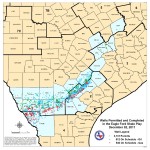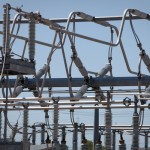Oil Boom Raises Electric Rates in Parts of Texas

Photo by Jim Weber/The Commercial Appeal
As the drilling boom grows in parts of Texas, so has the demand for power, leading to an energy crunch. In this photo, Michael Stephens repairs a power line in South Memphis.
Texas is often called the energy capital of America, so it might come as a surprise that the oil and gas boom has substantially driven electric prices up in some parts of the state. And in those same areas, prices are expected to spike again this summer.
To understand why, it’s best to start with the small city of Seymour, which is somewhere between Wichita Falls and Abilene. Fewer than 3,000 people call it home.
“We are a small West Texas Community that, like all West Texas communities, is struggling with every cent is important to us,” says John Studer, Seymour’s city manager.
The town of Seymour runs its own electric utility. It buys on the wholesale market and sells power to its citizens. Voters have control of their utility, and profits go to the city. Studer says it’s worked pretty well. Until last year when the electric bills started going up.
“Every one that came in, it just kept progressively getting higher and then when you get one up for ten percent of your bill for congestion charges,” Studer explains. “It kind of takes your breath away.”
If the city was paying $200,000 dollars on a bill, it suddenly owed $20,000 more for congestion charges. That’s a lot of money for a place like Seymour.
What are congestion charges? Those are fees charged for an overtaxed electric system. And small towns like Seymour aren’t the only ones paying more these days.
On a recent Thursday, at a banquet hall at the Petroleum Club of Midland, Kent Saathoff, from the Electric Reliability Council of Texas (ERCOT), had some bad news for local municipalities. Not only would prices go up again in West Texas this summer, but it was kinda their own fault.
“Essentially, the transmission system we have out here today was largely built to serve the load that was there before this great increase in oil drilling activity,” Saathoff said.
All those pumps jacks and drill rigs working overtime during the fracking boom use electricity. It used to be that cost was spread across the state, so no one consumer was hit too hard by it. But since ERCOT changed the way the grid worked a few years agom to what’s called a “nodal system,” the price of congestion stays closer to the areas where it exists. That’s why some areas near the South Texas oil fields have seen congestion costs rise as well.
“It’s very much like in Austin for example,” Saathoff told the audience. “Roads can’t be built fast enough to take care of all the additional people moving there.”
As John Bick put it, “the problem is that the toothpaste is already out of the tube.” He’s with the energy consulting firm Priority Power Management. He works with the city of Midland, where prices have also gone up, and he says grid planners should have seen this coming.
“The planning for transmission to serve oil and gas production in West Texas, there were some short comings in that process and so it takes time to build transmission,” Bick said.
Bick is lobbying for price caps on congestion fees. But there’s a catch. Some people are actually profiting from those fees. ERCOT auctions off something called congestion revenue rights. So power companies and investors can make money when the lines are overloaded.
StateImpact Texas asked ERCOT for a list of the companies that had made money off this recent round of congestion, but was told that information is protected by competitive secrets rules.
In Midland, some oil and gas companies talk about the possibility of buying them themselves as a way to hedge against future price hikes.
But far from the oilfields back in Seymour, City Manager John Studer says his town probably couldn’t afford to dabble in the transmission markets.
“You can’t write the rules to fit everybody, but it sure does come down sometimes hard on some people,” Studer said.
He says Seymour has a new electric contract that should provide better rates in the short term.
In the long term, West Texas will have to cut down on electric use or build more transmission lines to see lower electric bills – at least as long as the current drilling boom lasts.

